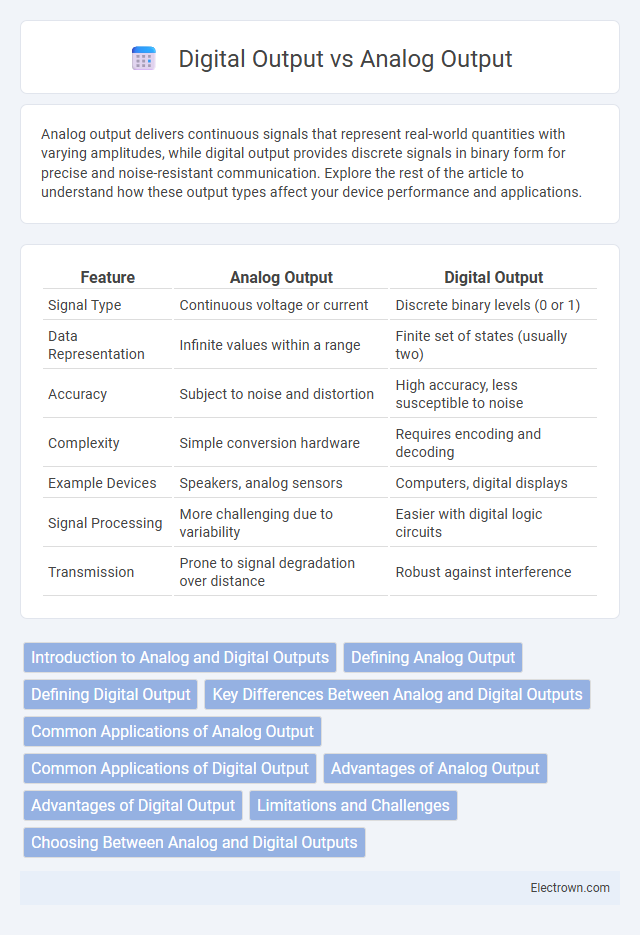Analog output delivers continuous signals that represent real-world quantities with varying amplitudes, while digital output provides discrete signals in binary form for precise and noise-resistant communication. Explore the rest of the article to understand how these output types affect your device performance and applications.
Table of Comparison
| Feature | Analog Output | Digital Output |
|---|---|---|
| Signal Type | Continuous voltage or current | Discrete binary levels (0 or 1) |
| Data Representation | Infinite values within a range | Finite set of states (usually two) |
| Accuracy | Subject to noise and distortion | High accuracy, less susceptible to noise |
| Complexity | Simple conversion hardware | Requires encoding and decoding |
| Example Devices | Speakers, analog sensors | Computers, digital displays |
| Signal Processing | More challenging due to variability | Easier with digital logic circuits |
| Transmission | Prone to signal degradation over distance | Robust against interference |
Introduction to Analog and Digital Outputs
Analog outputs provide continuous voltage or current signals that vary smoothly over a range, representing real-world phenomena like temperature or pressure with precision. Digital outputs, in contrast, deliver discrete on/off signals, suited for simple binary control such as turning devices on or off. Understanding the fundamental differences helps you select the appropriate output type for accurate data representation or device control in various industrial and electronic applications.
Defining Analog Output
Analog output delivers continuous signals that vary smoothly over a range, representing physical quantities such as temperature, pressure, or voltage. Unlike digital output, which switches between discrete states (0 or 1), analog signals provide precise and fine-grained control in applications like audio equipment, sensors, and industrial automation. Devices with analog output transmit variable voltages or currents to accurately mimic real-world phenomena.
Defining Digital Output
Digital output refers to a binary signal that switches between discrete voltage levels, typically representing two states: ON (1) or OFF (0). This type of output is commonly used in electronics and control systems for devices that require clear, unambiguous signals such as switches, LEDs, and relays. Your choice between analog and digital output depends on whether precise, continuous control or simple on/off operation is needed.
Key Differences Between Analog and Digital Outputs
Analog output delivers continuous signals that vary smoothly over a range, representing real-world phenomena such as temperature or sound with infinite resolution. Digital output provides discrete signals typically in binary form, enabling precise and noise-resistant communication ideal for on/off states or quantized data. Key differences include signal representation, resolution, and susceptibility to noise, with analog outputs offering variable voltage or current levels and digital outputs relying on fixed logic levels.
Common Applications of Analog Output
Analog output is frequently used in applications requiring continuous variable signal control such as temperature regulation in HVAC systems, motor speed adjustments in industrial automation, and audio signal processing. It enables precise control of devices like actuators, valves, and sensors by providing proportional voltage or current levels. Industries including manufacturing, robotics, and instrumentation extensively utilize analog output for real-time monitoring and control.
Common Applications of Digital Output
Digital output signals are widely used in automation systems, industrial machinery, and consumer electronics to control devices such as relays, LEDs, and motors. These signals represent binary states, enabling precise on/off control and integration with programmable logic controllers (PLCs) for efficient process management. Common applications include switching power supplies, status indicators, and communication interfaces in embedded systems.
Advantages of Analog Output
Analog output provides continuous signal variations that enable precise control over devices such as motors, sensors, and audio equipment. This capability allows for smoother operation and more accurate representation of real-world values compared to the discrete steps of digital output. Additionally, analog signals are often simpler to interface with legacy systems that rely on voltage or current levels.
Advantages of Digital Output
Digital output provides precise and noise-resistant signals, ensuring consistent and reliable data transmission in various electronic systems. It allows easy integration with microcontrollers and digital circuits, enabling efficient processing and control in automation and communication applications. Enhanced compatibility with software-based systems and error detection techniques further increases the overall system accuracy and performance.
Limitations and Challenges
Analog output faces limitations such as signal degradation over long distances and susceptibility to noise, which can impact accuracy and reliability. Digital output challenges include limited resolution due to discrete signal levels and potential latency in signal processing. Understanding these constraints helps you choose the appropriate output type for precise control and data communication needs.
Choosing Between Analog and Digital Outputs
Choosing between analog and digital outputs depends on the precision and type of signal your application requires. Analog outputs provide continuous voltage or current signals ideal for representing varying physical quantities, while digital outputs deliver discrete on/off states suitable for binary control systems. Your decision should consider factors such as signal resolution, noise susceptibility, and compatibility with existing equipment.
Analog Output vs Digital Output Infographic

 electrown.com
electrown.com